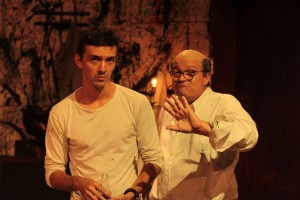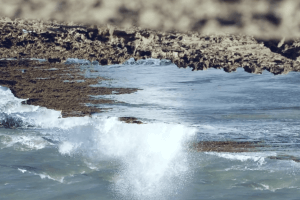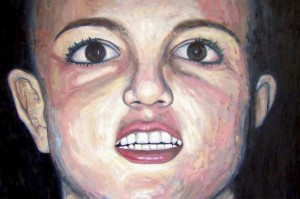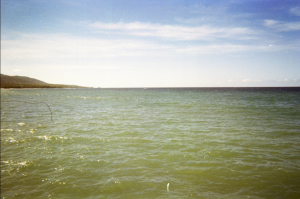In a corner the size of a corn kernel
teems the minimal as an enlarged pigeon
Luis Enrique Belmonte
Minimal movements arose amidst the psychic maneuvers to sustain the day in a moment of self-absorption and impossibility of verbal articulation; I have thought of this as a structure of wooden sticks that shelters me against all hope. Sometimes the space that lodges the creative process of poetry is nourished by silence and contemplation; it is a work of depth and forge, of inward observation in the complicated outside.
Suddenly I saw how a painting contained a very dim scene: some little flowers moving in the wind. I took my cell phone and recorded that temporary space in order to frame it in a kind of box that would embrace and preserve it. Thus, small takes began to occur, which I took to be verses of a long enumerative poem; as a composition of images, perhaps dissimilar to each other, grouped under certain common features: repetition, a path framed between the angles of a microscopic take, the need of capturing subtle, tiny movements or unexpected shifts within the landscape. Slow movements where the imperceptible was revealed, as if a halo made palpable the invisible within the space. These days, a droopy and thoughtful walk has made me see the tiny and so obvious details, so overused or insignificant that they drown in themselves. It has been the looking at things, and resolutely attending to «awakening,» to that state of the experience of seeing that Rafael Cadenas proposes in his poetics and in his vital walk that «has to do with the present, with the attention, with an awareness of the sensations,» with perceiving the extraordinary in the ordinary, the mystery that emanates from simple things when you really see them.
I do fixed shots or at least I try. Most times, I hold them by pulse. Daily, I record those movements that appear in my path. I’m in a certain state of drift. Sometimes I have felt like the poet in the novel The Walk by Robert Walser, who declared himself in a «romantic-extravagant state of mind», searching for situations that surprise me by their magnificent simplicity. I stare at those tiny little things I saw as a child in the garden of the house; the bee with its legs loaded with pollen (I desire that shot, and I chase it), the row of bachacos carrying the pieces of leafs with their pliers, the morbid depth of a fishbowl, the shifting of a sloth, the breathing of a cat, the concert of shadows of leaves of tall trees on the cement floor in the afternoon, the unfolding of what is seen for the first time.
I know that choosing a shot of an object is to anchor one of its multiple and unlimited variations of movement. Merleau Ponty so finely grasps the process of perception of the object, that I can only quote him to explain myself: “to look at an object is to inhabit it, and from this habitation to grasp all things in terms of the aspect which they present to it. But in so far as I see those things too, they remain abodes open to my gaze, and, being potentially lodged in them, I already perceive from various angles the central object of my present vision.” This perspective also locks the gaze from the temporal point of view, from the moment when I look and record that little breath of time, I take it away from the other possibilities of the gaze. It was this and not another shot that I captured and made my own, perhaps as a fixed memory in my mind (and I know that this is impossible, as memory will be transfigured every time I remember). A video recorded and inserted online, susceptible to the slightest movement of a finger on the mouse or on the screen, installed in its duration in the look and memory of another; though fleeting in the vertigo of images online, perhaps it makes its mark of slowness on the ones who looked at it inward as well.
The idea of making that first take about the tiny flowers arose together with the need to share, in my social networks, that captured space. To transfer those #minimalmovements to that other place where I spend so many hours, agreeing to forms and articulations of a written and visual communication, mediated by predetermined platforms and conventions. Facebook and Instagram, full of pre-made content, memes, Gif and videos that fit into recipes of emotions arranged to the highest bidder; with a rapid movement, uploaded to their profile and used to declare their happiness, their discomfort or any chatter or advice pertinent to what they think or feel.
My series of videos, with its morosity, has permeated through that highway of images and information, and has become viral, not from the image or from what they show, that, in the end, are my small compliments to slowness, but from the gaze. The receptivity of my friends to these small spaces within the landscape has manifested itself in the creation of their own minimal movements, which they began to share in my portal and that have multiplied under the hashtag #mínimosmovimientos.
Within this gazing onto the spaces of Facebook and Instagram, I value and have been inspired by the presence of Venezuelan artists who tenaciously insert their work in these networks: José Vívenes, Hayfer Brea, Angela Bonadies, to name a few. But in a special way, I highlight Consuelo Mendez’s daily record of the spaces in her garden; details and approaches of the lens on leaves, fruits, reflections of light on organic surfaces, humidity, shadows, the first hour of the morning, cats, earth, logs: her pocket forest. Every morning Consuelo tells me that, no matter how limited –physically, politically, economically– we may be in a space, in a city, in a country, it’s always possible to save ourselves through the intimate gaze of the tiny and the unnoticed, at the margin of disaster.
*About the author
Eleonora Requena (Caracas, 1968). Venezuelan poet. She studied Literature at Universidad Católica Andrés Bello (Ucab). She participated in the literary creation workshops of the Center for Latin American Studies Rómulo Gallegos (Celarg). She completed the Diploma in Art Criticism of the School of Arts at UCV (2012). She participated in the Experimental Curatorial Workshop III-2013 at Periférico Caracas-Arte Contemporáneo. She has published the collection of poems Sed (Eclepsidra, 1998), mandados (La Liebre Libre, 2000), Es de día (El Pez Soluble, 2004), La Noche y sus agüeros (El Pez Soluble, 2007), Ética del aire (bid & co. editor, 2008) y Nido de tordo (Kalathos editores, 2015) Her work has appered in various anthologies and critical studies publications inside and outside her country. With mandados she won the Prize of the V Latin American Poetry Biennial José Rafael Pocaterra (2000), while with La Noche y sus agüeros she won the Premio Italia 2007 for Poetry in the contest «Mediterranean and Caribbean», sponsored by the Italian Institute of Culture of Venezuela and the Contemporary Poetry Center of the University of Bologna.
.















